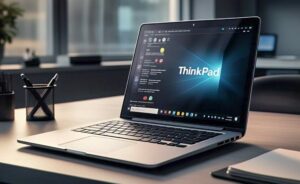
Is your Lenovo ThinkPad refusing to power on? This comprehensive troubleshooting guide will walk you through all possible solutions – from basic power checks to advanced hardware diagnostics – to get your laptop working again. Follow our step-by-step instructions to diagnose and fix the problem quickly.
Common Reasons Why Your ThinkPad Won’t Turn On
Power Supply Issues
Faulty adapters, damaged cords, or loose connections can prevent power from reaching your ThinkPad.
Battery Problems
Depleted, deteriorated, or malfunctioning batteries are common culprits when ThinkPads fail to start.
Hardware Failures
Issues with the motherboard, RAM, or other internal components can prevent your ThinkPad from powering on.
BIOS/Firmware Issues
Outdated or corrupted BIOS settings can interfere with the normal boot process of your ThinkPad.
Overheating
Excessive heat buildup from regular use can trigger protective shutdowns and prevent your ThinkPad from starting.
Basic Power Troubleshooting Steps
1. Verify Power Connections
- Ensure the power cord is securely connected to both the laptop and wall outlet
- Look for physical damage to the adapter, cables, plugs, or charging pins
- Test the outlet by plugging another device into it to confirm it’s working
2. Observe Indicator Lights
Check if any lights illuminate when the ThinkPad is plugged in:
- Power indicator light (usually near the power button)
- Battery status indicator
- Charging indicator
These lights can provide clues about whether power is reaching your laptop.
⚠️ PRO TIP
Before performing any advanced troubleshooting, try a simple power drain: Unplug your ThinkPad, remove the battery (if possible), and hold the power button for 30 seconds. This discharges residual power that might be causing issues.
Battery Reset Procedure
- Disconnect all power sourcesUnplug the AC adapter and remove the battery if your ThinkPad model allows it.
- Power button drainHold the power button for 30-60 seconds to discharge any residual power in the system.
- Reconnect powerPlug in the AC adapter (without battery) and attempt to power on the laptop.
- Reinsert batteryIf the laptop starts without the battery, shut down completely and reinsert the battery.
Advanced Troubleshooting Techniques
BIOS Reset Methods
Using the BIOS Reset Button:
- Locate the BIOS reset button (often a pinhole on the bottom or side of the laptop)
- Insert a paperclip and gently press for a few seconds
- Attempt to power on your ThinkPad normally
CMOS Battery Reset:
- Open the laptop and disconnect the CMOS battery (requires some technical experience)
- Wait 2-5 minutes before reconnecting
- This can resolve issues where the laptop goes to sleep and won’t wake up
Hardware Checks
RAM Troubleshooting:
- Remove and reseat RAM modules
- If your ThinkPad has multiple RAM slots, try using only one module at a time
- Test with known working RAM if available
Internal Component Check:
- Disconnect and reconnect internal components (requires some technical knowledge)
- Check for any loose connections inside the laptop
- Inspect for signs of physical damage or liquid exposure
Software Solutions
Disable Fast Startup:
If you can occasionally get your ThinkPad to boot:
- Open Control Panel > Power Options
- Click “Choose what the power buttons do”
- Click “Change settings that are currently unavailable”
- Uncheck “Turn on fast startup”
- Save changes
This can prevent sleep/wake issues that interfere with proper startup.
Using the ThinkPad Novo Button
Many ThinkPad models feature a special recovery button called the Novo button:
- Locate the Novo buttonLook for a small pinhole button on the side or near the power button of your ThinkPad.
- Press the buttonInsert a paperclip into the Novo button hole and press gently while the computer is off.
- Access recovery optionsThis should bring up the BIOS and recovery options menu, which may help you diagnose the issue.
Diagnostic Tip: If your ThinkPad powers on using the Novo button but not the power button, the issue is likely with the power button itself.
When to Seek Professional Help
If you’ve tried all the above solutions and your ThinkPad still won’t turn on, you may be facing one of these more serious issues:
Motherboard Failure
Requires component-level repair or replacement
Graphics Card Problems
May require specialized diagnosis and repair
Hard Drive Failure
May require data recovery and drive replacement
DC Power Jack Damage
Requires soldering and specialized repair
⚠️ IMPORTANT
Before taking your ThinkPad for professional repair, try to back up any important data if possible. If the laptop powers on intermittently, use those opportunities to save your files.
Prevention Tips for Future Power Issues
Regular Maintenance
- Keep your BIOS and drivers updated regularly
- Run system diagnostics periodically
- Clean cooling vents and fans to prevent overheating
Proper Usage Habits
- Use on hard, flat surfaces to prevent overheating
- Avoid extreme temperatures
- Shut down properly instead of using sleep mode constantly
Power Management
- Use official Lenovo power adapters
- Consider disabling Fast Startup if you experience recurring issues
- Allow battery to fully discharge occasionally
Frequently Asked Questions
Conclusion: Getting Your ThinkPad Working Again
When your ThinkPad won’t turn on, start with the basics: check power connections, try a battery reset, and examine power indicators. If these steps don’t work, progress to more advanced troubleshooting like BIOS resets, hardware checks, and using the Novo button.
Remember that most ThinkPad power issues can be resolved with careful troubleshooting, but some may require professional repair, especially if they involve the motherboard or other core components.
By following proper maintenance practices and using official accessories, you can minimize the chance of experiencing power issues with your ThinkPad in the future.
Last Updated: March 17, 2025
This troubleshooting guide is based on extensive research and official Lenovo support documentation. While these solutions work for most ThinkPad models, some newer ThinkPads may have different procedures. Always consult your specific model’s user manual for the most accurate information. Check us out at www.softwarestudylab.com
